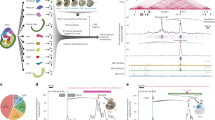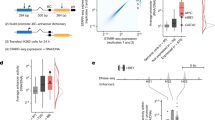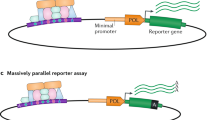Abstract
This protocol describes the use of Enhancer Element Locator (EEL), a computer program that was designed to locate distal enhancer elements in long mammalian sequences. EEL will predict the location and structure of conserved enhancers after being provided with two orthologous DNA sequences and binding specificity matrices for the transcription factors (TFs) that are expected to contribute to the function of the enhancers to be identified. The freely available EEL software can analyze two 1-Mb sequences with 100 TF motifs in about 15 min on a modern Windows, Linux or Mac computer. The output provides several hypotheses about enhancer location and structure for further evaluation by an expert on enhancer function.
This is a preview of subscription content, access via your institution
Access options
Subscribe to this journal
Receive 12 print issues and online access
$259.00 per year
only $21.58 per issue
Buy this article
- Purchase on Springer Link
- Instant access to full article PDF
Prices may be subject to local taxes which are calculated during checkout









Similar content being viewed by others
References
Hallikas, O. et al. Genome-wide prediction of mammalian enhancers based on analysis of transcription-factor binding affinity. Cell 124, 47–59 (2006).
Cameron, R.A. et al. An evolutionary constraint: Strongly disfavored class of change in DNA sequence during divergence of cis-regulatory modules. Proc. Natl. Acad. Sci. USA 102, 11769–11774 (2005).
Tompa, M. et al. Assessing computational tools for the discovery of transcription factor binding sites. Nat. Biotechnol. 23, 137–144 (2005).
Bejerano, G. et al. Ultraconserved elements in the human genome. Science 304, 1321–1325 (2004).
Nazina, A.G. & Papatsenko, D.A. Statistical extraction of Drosophila cis-regulatory modules using exhaustive assessment of local word frequency. BMC Bioinformatics 4, 65 (2003).
Grad, Y.H., Roth, F.P., Halfon, M.S. & Church, G.M. Prediction of similarly-acting cis-regulatory modules by subsequence profiling and comparative genomics in D. melanogaster and D. pseudoobscura. Bioinformatics 20, 2738–2750 (2004).
Segal, E. & Sharan, R. A discriminative model for identifying spatial cis-regulatory modules. J. Comput. Biol. 12, 822–834 (2005).
Durbin, R., Eddy, S.R., Krogh, A. & Mitchison, G. Biological Sequence Analysis: probabilistic Models of Proteins and Nucleic Acids (Cambridge Univ. Press, Cambridge, 1998).
Berman, B.P. et al. Exploiting transcription factor binding site clustering to identify cis-regulatory modules involved in pattern formation in the Drosophila genome. Proc. Natl. Acad. Sci. USA 99, 757–762 (2002).
Alkema, W.B., Johansson, O., Lagergren, J. & Wasserman, W.W. MSCAN: identification of functional clusters of transcription factor binding sites. Nucleic Acids Res. 32, 169–176 (2004).
Sharan, R., Ovcharenko, I., Ben-Hur, A. & Karp, R.M. CREME: a framework for identifying cis-regulatory modules in human-mouse conserved segments. Bioinformatics 19, i283–i291 (2003).
Donaldson, I.J. et al. Genome-wide identification of cis-regulatory sequences controlling blood and endothelial development. Hum. Mol. Gene. 14, 595–601 (2005).
Philippakis, A.A., He, F.S. & Bulyk, M.L. Modulefinder: a tool for computational discovery of cis regulatory modules. in Proc. of the Pacific Symp. of Biocomputing 519–530 (2005).
Blanchette, M. et al. Genome-wide computational prediction of transcriptional regulatory modules reveals new insights into human gene expression. Genome Res. 16, 656–668 (2006).
Zhou, Q. & Wong, W.H. CisModule: De novo discovery of cis-regulatory modules by hierarchical mixture modeling. Proc. Natl. Acad. Sci. USA 101, 12114–12119 (2004).
Rajewsky, N., Vergassola, M., Gaul, U. & Siggia, E.D. Computational detection of genomic cis-regulatory modules applied to body patterning in the early Drosophila embryo. BMC Bioinformatics 3, 30 (2002).
Sinha, S., van Nimwegen, E. & Siggia, E.D. A probabilistic method to detect regulatory modules. Bioinformatics, 19, i292–i301 (2003).
Bailey, T.L. & Noble, W.S. Searching for statistically significant regulatory modules. Bioinformatics 19, 16–25 (2003).
Frith, M.C., Li, M.C. & Weng, Z. Cluster-Buster: finding dense clusters of motifs in DNA sequences. Nucleic Acids Res. 31, 3666–3668 (2003).
Xie, X. et al. Systematic discovery of regulatory motifs in human promoters and 3′ UTRs by comparison of several mammals. Nature 434, 338–345 (2005).
Wasserman, W.W. & Sandelin, A. Applied bioinformatics for the identification of regulatory elements. Nat. Rev. Genet. 5, 276–287 (2004).
Sinha, S. et al. Cross-species comparison significantly improves genome-wide prediction of cis-regulatory modules in Drosophila. BMC Bioinformatics 5, 129 (2004).
Vlieghe, D. et al. A new generation of JASPAR, the open-access repository for transcription factor binding site profiles. Nucleic Acids Res. 34, D95–D97 (2006).
Hallikas, O. & Taipale, J. High-throughput assay for determining specificity and affinity of protein-DNA binding interactions. Nat. Protoc. 10.1038/nprot2006. 33 (2006).
Birney, E. et al. Ensembl 2006. Nucleic Acids Res. 34, D556–D561 (2006).
Kent, W.J. et al. The Human Genome Browser at UCSC. Genome Res. 12, 996–1006 (2002).
Benson, G. Tandem repeats finder: a program to analyze DNA sequences. Nucleic Acids Res. 27, 573–580 (1999).
Acknowledgements
This work was supported by the 'Translational Genome-Scale Biology' and the 'From Data to Knowledge' Centers of Excellence of the Academy of Finland and by the 'BioSapiens' and the 'Regulatory Genomics' projects of the European Union.
Author information
Authors and Affiliations
Corresponding author
Ethics declarations
Competing interests
The authors declare no competing financial interests.
Rights and permissions
About this article
Cite this article
Palin, K., Taipale, J. & Ukkonen, E. Locating potential enhancer elements by comparative genomics using the EEL software. Nat Protoc 1, 368–374 (2006). https://doi.org/10.1038/nprot.2006.56
Published:
Issue Date:
DOI: https://doi.org/10.1038/nprot.2006.56
This article is cited by
-
The distribution of transposable elements (TEs) in the promoter regions of moso bamboo genes and its influence on downstream genes
Trees (2018)
-
The Wilms Tumor-1 (WT1) rs2234593 variant is a prognostic factor in normal karyotype acute myeloid leukemia
Annals of Hematology (2016)
-
D-Light on promoters: a client-server system for the analysis and visualization of cis-regulatory elements
BMC Bioinformatics (2013)
-
Enhancer identification in mouse embryonic stem cells using integrative modeling of chromatin and genomic features
BMC Genomics (2012)
-
The 14q22.2 colorectal cancer variant rs4444235 shows cis-acting regulation of BMP4
Oncogene (2012)
Comments
By submitting a comment you agree to abide by our Terms and Community Guidelines. If you find something abusive or that does not comply with our terms or guidelines please flag it as inappropriate.



